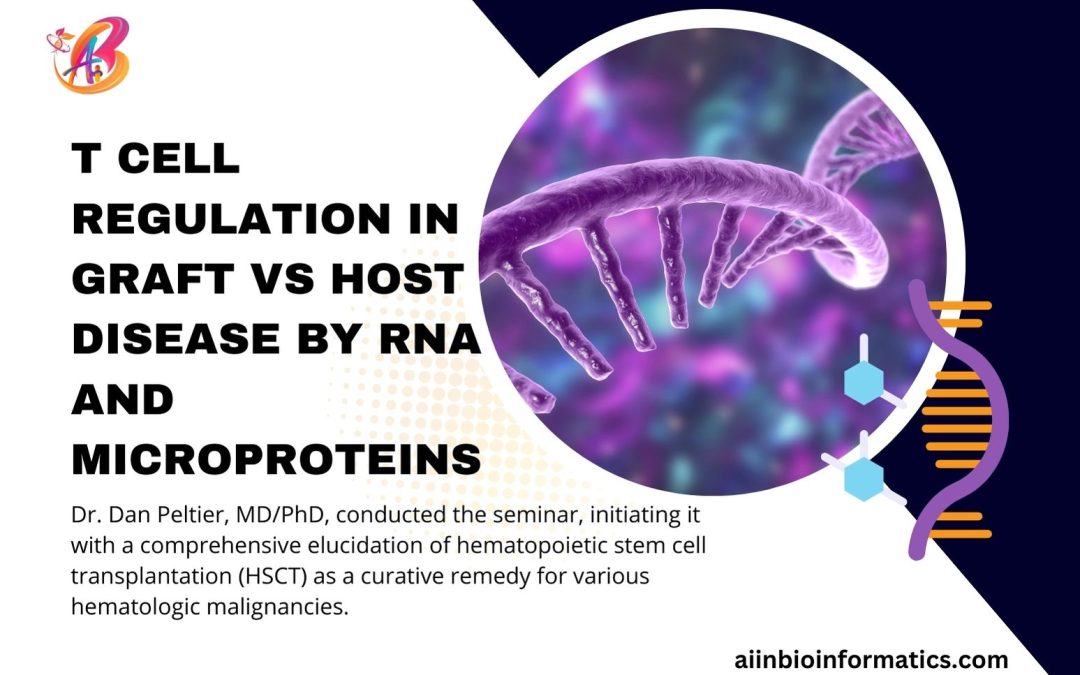Title of the seminar: Long Non-coding RNA and Cryptic Microprotein Regulation of T cells in Acute Graft Versus Host Disease
Date: 11/09/2023
Local Host: Indiana University School of Medicine
Presenter: Dr. Dan Peltier, MD/PhD
Reported by: Swaraj Thorat
Introduction
Dr. Dan Peltier, MD/PhD, conducted the seminar, initiating it with a comprehensive elucidation of hematopoietic stem cell transplantation (HSCT) as a curative remedy for various hematologic malignancies. The field of hematology has witnessed a remarkable revolution with the advent of hematopoietic stem cell transplantation (HSCT). This transformative therapy has offered a glimmer of hope for patients battling a range of hematological malignancies, providing a potential cure for conditions that were once deemed incurable.
However, allogeneic HSCT, where donor stem cells are employed, comes with an inherent risk: acute graft-versus-host disease (GVHD). This immune-mediated attack against the recipient’s tissues casts a shadow over this otherwise promising treatment. Despite significant advancements in immune suppression strategies, GVHD remains a formidable challenge, affecting approximately half of allogeneic HSCT recipients. This underscores the urgent need for innovative therapeutic approaches to effectively prevent and manage GVHD.
Long Non-Coding RNAs (lncRNAs)
Unveiling Hidden Players in HSCT Long non-coding RNAs (lncRNAs) have emerged as captivating players in the intricate symphony of biological processes. These enigmatic molecules, exceeding 200 nucleotides in length, do not code for proteins, yet they wield a profound influence on gene expression and cellular functions. Their tissue-specific expression patterns and their ability to modulate gene expression make lncRNAs compelling candidates for biomarker development and therapeutic targeting in the context of HSCT.
LINC00402
Intriguingly, comprehensive analyses of patient cells derived from both autologous and allogeneic HSCT recipients have revealed the differential expression of various lncRNAs. Among these, LINC00402 has emerged as a star candidate for further exploration due to its consistent differential expression across independent patient cohorts, its evolutionary conservation among mammals, and its pronounced T cell specificity.
Deciphering the Regulation and Functions of LINC00402
Unraveling the mechanisms that govern the regulation and functions of LINC00402 has been a captivating endeavor. Mechanistic studies have unveiled an unexpected twist: LINC00402 expression exhibits a paradoxical decrease upon T cell receptor activation in allogeneic HSCT T cells. This counterintuitive finding has ignited a quest to illuminate the molecular mechanisms underlying its regulation.
A Therapeutic Promise in GVHD Management
The therapeutic potential of LINC00402 has ignited a surge of excitement in the HSCT arena. Overexpression of human LINC00402 in mouse T cells has demonstrated a remarkable ability to mitigate acute GVHD, providing compelling evidence of its therapeutic potential. Further investigations have revealed an intriguing mechanism: LINC00402 promotes an increase in regulatory T cell (Treg) percentage without significantly altering phosphor-ERK levels, suggesting a unique mode of action.
Cryptic lncRNAs and Microproteins
The discovery of microproteins encoded within lncRNAs has added an intricate layer of complexity to the regulatory landscape. These elusive microproteins, though often overlooked, may harbor distinct functions, potentially influencing cellular processes in ways yet to be fully understood. Future studies should embark on a mission to investigate the presence and functional implications of microproteins encoded by LINC00402.
Conclusion
The identification and characterization of LINC00402 have opened a new chapter in our understanding of the intricate interplay between lncRNAs and immune regulation in the context of HSCT. As we delve deeper into its functions and mechanisms of action, we may uncover novel insights into GVHD pathogenesis, paving the way for the development of effective therapeutic strategies to improve patient outcomes. The future of HSCT holds immense promise, and LINC00402 stands as a beacon of hope, guiding us towards a brighter horizon.

